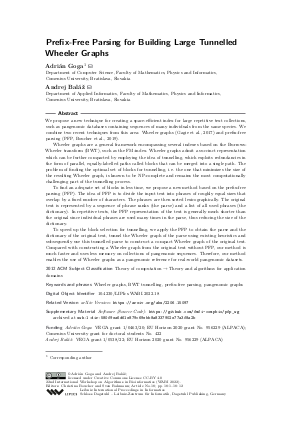LIPIcs.WABI.2022.18.pdf
- Filesize: 0.67 MB
- 12 pages

 Creative Commons Attribution 4.0 International license
Creative Commons Attribution 4.0 International license

We propose a new technique for creating a space-efficient index for large repetitive text collections, such as pangenomic databases containing sequences of many individuals from the same species. We combine two recent techniques from this area: Wheeler graphs (Gagie et al., 2017) and prefix-free parsing (PFP, Boucher et al., 2019). Wheeler graphs are a general framework encompassing several indexes based on the Burrows-Wheeler transform (BWT), such as the FM-index. Wheeler graphs admit a succinct representation which can be further compacted by employing the idea of tunnelling, which exploits redundancies in the form of parallel, equally-labelled paths called blocks that can be merged into a single path. The problem of finding the optimal set of blocks for tunnelling, i.e. the one that minimizes the size of the resulting Wheeler graph, is known to be NP-complete and remains the most computationally challenging part of the tunnelling process. To find an adequate set of blocks in less time, we propose a new method based on the prefix-free parsing (PFP). The idea of PFP is to divide the input text into phrases of roughly equal sizes that overlap by a fixed number of characters. The phrases are then sorted lexicographically. The original text is represented by a sequence of phrase ranks (the parse) and a list of all used phrases (the dictionary). In repetitive texts, the PFP representation of the text is generally much shorter than the original since individual phrases are used many times in the parse, thus reducing the size of the dictionary. To speed up the block selection for tunnelling, we apply the PFP to obtain the parse and the dictionary of the original text, tunnel the Wheeler graph of the parse using existing heuristics and subsequently use this tunnelled parse to construct a compact Wheeler graph of the original text. Compared with constructing a Wheeler graph from the original text without PFP, our method is much faster and uses less memory on collections of pangenomic sequences. Therefore, our method enables the use of Wheeler graphs as a pangenomic reference for real-world pangenomic datasets.

















Feedback for Dagstuhl Publishing